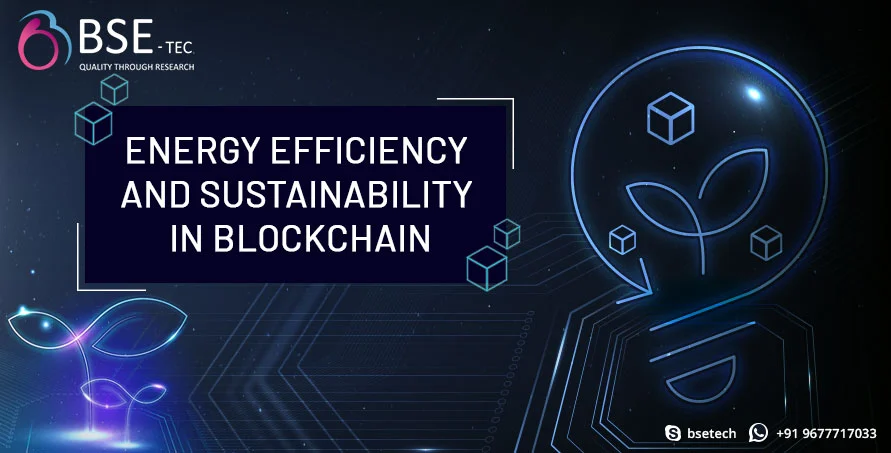Energy Efficiency and Sustainability in Blockchain

The road to energy efficiency is, in theory, a sustainability sweepstake. More efficiency means that less fuel is required to generate a given amount of energy, which in turn means lower costs for the provider and cheaper prices for the customers.
Jens Martin Skibsted
We are moving towards a net-zero carbon emission mission with a billion-dollar question “What can be done to make all our processes more sustainable to save our natural capital: Earth?” Here is a quick overview of how energy efficiency and sustainability are interconnected and how blockchain can help us to achieve our sustainability goals.
What Products Are Not Sustainable?
Products that use resources (like fossil fuels) that take time to replenish again. In short, the products, industries, and machines that use more non-renewable resources are non-sustainable.
Why Do We Need Energy Efficiency To Promote Sustainability?
Energy efficiency and sustainability are essentially interconnected and it is safe to say these are the results of cause and effect. Efficiency promotes sustainability.
Note: By blockchain and cryptocurrency, we discuss all the cryptocurrencies and blockchain platforms that use PoS as a consensus mechanism which does not include the Bitcoins and Bitcoin network.
Discover why Bitcoin is bad for the environment.
The International Energy Agency (IEA) has stated that improved energy efficiency in industrial processes, transportation, and buildings could lead to a 30% reduction in the world’s energy needs by 2050 and help control global emissions of greenhouse gasses.
How Blockchain Contributes To Sustainable Development?
Blockchain is a more promising new-age technology that is already disrupting many sectors. Here is how it contributes to energy efficiency and sustainability.
1. Decentralized Architecture: Blockchain operates on a decentralized network of computers, known as nodes, which work together to validate and record transactions. This distributed nature eliminates the need for a central authority, such as a bank or a government, to verify transactions. As a result, blockchain reduces the energy consumption associated with traditional centralized systems.
Here is a statistical report from a digital galaxy about the energy consumption of banks, gold, and Bitcoin. It is unequivocal about the decentralized (no intermediaries) nature of cryptocurrency. It is also to be noted that if bitcoin energy consumption is less, then blockchains with PoS consensus mechanisms cut off more energy in their transactions paving the way for a greener environment.
2. Smart Contracts: Blockchain platforms often support the use of smart contracts, which are self-executing agreements with predefined rules. Smart contracts automate and streamline various processes, reducing the need for intermediaries and manual interventions. By eliminating intermediaries, smart contracts can increase efficiency, reduce costs, and save energy.
3. Peer-to-Peer Energy Trading: Blockchain can facilitate peer-to-peer energy trading, enabling individuals and organizations to buy and sell renewable energy directly without relying solely on centralized utility providers. This approach encourages the use of renewable energy sources and allows for efficient distribution and utilization of energy resources, leading to a decrease in carbon emissions.
Fiat money has a secondary impact through maintaining thousands of bank branches, employees using fossil-fuel-based transport to reach these offices and more than 3.5 million ATMs worldwide soaking up power 24/7.
4. Supply Chain Transparency: Blockchain can be utilized to create transparent and immutable records of transactions and data throughout supply chains. This transparency helps verify the authenticity and sustainability of products, such as food, diamonds, or renewable energy certificates. By ensuring the integrity of supply chains, blockchain discourages fraudulent or environmentally harmful practices, thereby promoting sustainability.
5. Carbon Credits and Offset Management: Blockchain-based platforms can be used to track and manage carbon credits and offsets. These systems allow for transparent recording and trading of carbon credits, ensuring that emissions reductions are accurately measured and accounted for. By increasing transparency and accountability, blockchain can enhance the effectiveness of carbon offset programs.
6. Energy Grid Optimization: With the integration of blockchain, energy grids can become more efficient and resilient. Blockchain technology can enable real-time monitoring, data analysis, and optimization of energy distribution and consumption. By optimizing energy grids, it becomes possible to minimize energy wastage, reduce reliance on non-renewable sources, and promote the use of renewable energy, consequently reducing carbon footprints.
Contact BSEtec for a free blockchain consultation on how your business can contribute to a greener earth by deploying a more sustainable business process using blockchain.
Did you find this article useful? Let us know by leaving a comment below, or join us on Twitter and Facebook.




